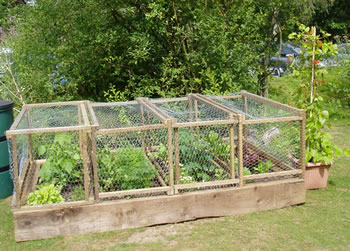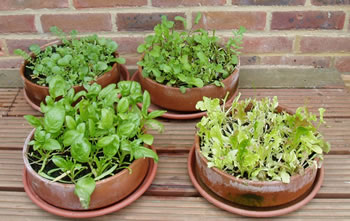
|
|||||||
Alternatives to digging beds for growing foodGrowing food does not have to involve annual digging over of beds at ground level. Here are a few ideas and tips on some alternative methods.
Raised BedsAccess: If you find that ‘the ground is a long way down’ and need or prefer to work the soil sitting or standing then you will need to construct walls at least 70cm high and solid enough to take the weight of the soil within them. Add a layer of rubble to allow drainage at the bottom and fill up with prepared top soil. Close cropping: If your aim is close cropping i.e. squeezing more plants into the same space then 20cm walls will suffice but you must dig over the ground beneath, remove perennial weeds and prepare it as you would for planting direct before building. Close cropping only gives a greater total yield if the individual plants have plenty of water and nutrients and this means rooting down into the soil below and a good soil rich in well rotted organic matter (WROM) above. Drainage: If you have poorly drained soil or a very high water table then raising the soil surface again by 20 or 30cm can provide the rich but not wet conditions that vegetables need. Improve the underlying drainage as well or a period of rain will see raised beds turn into raised bogs surrounded by flooded paths. Paths: Paths are vital to raised bed growing and you need to be able to reach the centre of the bed to plant and harvest; 3m x 1.2m is about the maximum size. Materials: never use old creosoted railway sleepers for a raised bed growing edible crops and check that all timber used has been treated with a suitable non-toxic preservative. use of creosoted sleepers for edible crops, where children play or people may sit became illegal in 2003 because of health risks associated with creosote. Forest GardeningForest Gardening is becoming better known as a method of more sustainable food production. The clue is in the name: a forest garden looks nothing like a traditional intensive allotment but mimics the natural growth of vegetation in layers and resembles perhaps more the edge of a wood than dense forest. In a nutshell (!) you plant fruit trees for the canopy, fruiting shrubs and climbers for the middle layer and vegetables and herbs as ground cover with sun-loving crops grown in clearings. There are no bought-in fertilisers; instead compost, green manure and nitrogen-fixing plants maintain fertility. It is a low maintenance approach, but can be very productive if well planned. Of course, as with wildlife gardening there has to be human intervention or the whole plot will revert to wilderness. Permaculture & no-dig“Permaculture” describes a whole lifestyle choice and social structure not just a system of growing food but the term is often used more casually to mean a no-dig, deep bed system. This involves creating 20-30cm raised beds and filling them with layers of different organic materials, alternating ‘green’ nitrogen rich material and ‘brown’ to supply carbon so you are effectively creating a compost heap, topped by soil. You plant into the top soil layer and do not ever dig down into the material below. As the organic matter fully rots down you layer on more each year and natural fungi, bacteria and worms do the work. One of the advantages of a no-dig system is that it encourages the build up of mycorrhizal fungi. The success of no-dig does seem to vary depending on the underlying soil that you have. Light, free draining soils can work well but heavy clay benefits from autumn digging to prevent compaction and poor drainage. You need huge amounts of organic matter, rotted as well as fresh and you do need to keep replenishing it each year. Mycorrhizal fungiNot strictly speaking a separate growing methond but Mycorrhizal fungi are becoming mre widely used too. Present naturally in the soil, they can be depleted in soil that has been deeply dug over, sterilised or treated with fungicides. These tiny fungi attach to the roots of plants and form a symbiotic (mutually beneficial) relationship: the fungus has a huge network of fine roots and increases the uptake of water and nutrients, especially phosphorus, making it available to the host plant; in return the plant supplies some food energy stored by photosynthesis to the fungus. It is thought that up to 85% of plant species benefit from some species of mycorrhizal fungus and that these organisms have been around for 400 million years. What is new though is the development of off-the-shelf products for gardeners to add to their soil, likely to be most use if you have bought in sterilised top soil or have a recently re-landscaped garden (they hate being disturbed) and least use if you have a long established organically improved soil which would have a healthy population anyway. The fungi do not travel far through the soil so need to be added in granule form close to the roots at planting time. Trials have shown significant results for establishment and growth of trees and shrubs but fungi preparations are also on sale aimed at herbaceous plants including vegetables. MulchingMulching is a key component of no-dig gardening but is one that is beneficial to any growing scheme. The aim of mulching is twofold: to retain water in the soil by reducing evaporation and reduce weed growth by excluding light. You can mulch with a variety of materials including stones & landscape fabric, but the best is well rotted organic matter as this brings a 3rd benefit: over time worms will drag it down into the root-zone and enrich the soil structure and nutrients. Chipped wood or bark also makes a good mulch that lasts longer and is clean and decorative. Fresh chippings do rot over time and if there is no green leafy content they can take nitrogen from the soil to decompose. To avoid this, I usually use chippings over landscape fabric for paths and shrubberies or over a layer of garden compost in flower beds. FinallyYou do not even need a garden to grow things to eat. Here are land cress, rocket, spinach and salad leaves growing in alpine pans suitable for a low wall or patio table top in the summer. |
|||||||
Article very kindly provided by Alison Marsden of Gardening by Design - providing gardeners in West Kent & East Sussex with coaching, advice and design ideas since 2004 |
DISCLAIMER:
Debby's Garden Links is not responsible for the content or reliability of any websites
linked from this site, and cannot accept liability for any damage or loss arising from
reliance on such websites
We cannot guarantee that these links will work all of the time
and we have no control over the availability of the linked pages
Submit a Free Link | Advertise your Business | Privacy Policy


